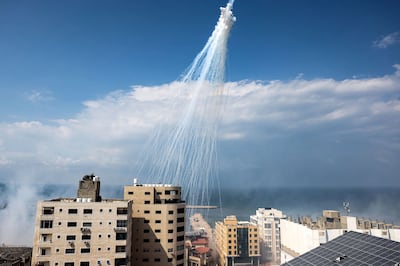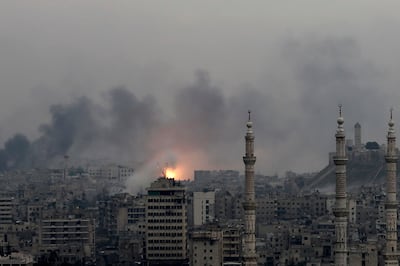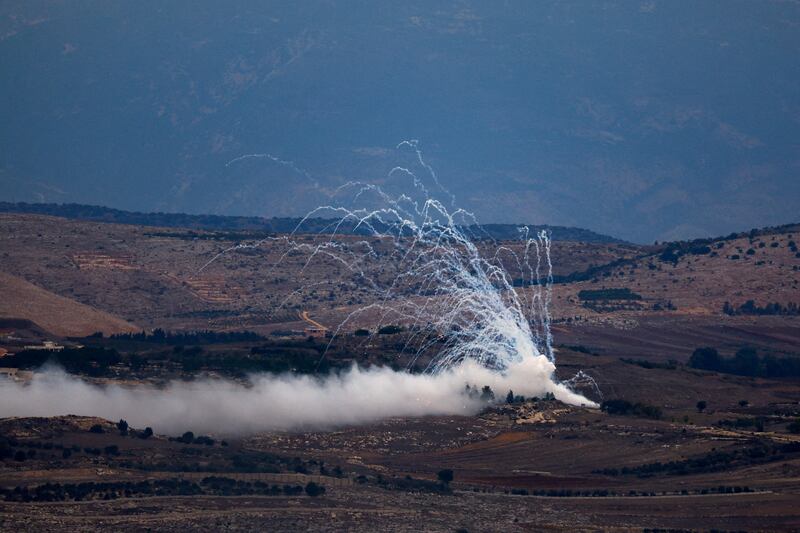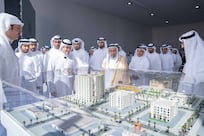Live updates: Follow the latest news on Israel-Gaza
Ex-Syrian rebel Rabih Sarraf was defending his hometown of Maarat Al Numan when Russian planes were bombing the area with white phosphorus seven years ago.
It is the same fearsome weapon Israel is suspected of having used in October in southern Lebanon, in low-intensity cross-border warfare linked to its almost two-and-half month operation against Hamas in Gaza.
Mr Sarraf, however, felt relatively safe when it was used on him and his fellow fighters.
He said Russian planes, by and large, avoided using white phosphorus munitions on the front lines "because regime forces were too close".
This has been a common problem for attacking forces where the defender is hiding in built-up areas or dense foliage, as in Gaza today or the jungles of Vietnam during the US-Communist war there.
Massive use of so-called wide-area effects weapons can kill or injure large numbers of enemy.
But the weapons, containing cluster bomblets, large amounts of shrapnel or incendiary substances, such as white phosphorus, are often too dangerous for the attacker to use in close combat without harming their own forces.
International rights organisations and Lebanese civilians spoken to by The National say Israel used the weapon last month on a village in southern Lebanon, causing only civilian casualties, echoing its use in the Syrian civil war against rebel areas.
It has been increasingly employed since the 2015 Russian intervention allowed forces loyal to President Bashar Al Assad to capture large parts of Syria that had fallen outside his control.
While civilians were incinerated or sustained gruesome burns, white phosphorus had little effect on entrenched rebels in tunnels, or spread out in terrain they know well, similar to Hezbollah and Hamas, former fighters said.

They cited long sieges, intense napalm and cluster munition bombing and shelling, and external backers abandoning the opposition to the President, as the main factors that eventually forced Syrian rebel cities and towns to surrender.
In Maarat Al Numaan, which was under rebel control from 2012 to 2020, Russian warplanes were "dropping white phosphorus mainly on the wooded outskirts of the city, and occasionally inside it", Mr Sarraf said by phone from the opposition-held city of Al Bab in northern Syria.
He fled there after Maarat Al Numan fell to the Assad regime three years ago.
Most of the white phosphorus casualties were Bedouin refugees from outlying areas who had taken shelter among the trees, he said.
"Phosphorus was useless militarily, except to inflict casualties on civilians who were in the open, or had taken cover under the trees, or to forests, and [to set] crops on fire," he said.
"Even when it hit the front lines, the tunnels and trenches we had built allowed us to deal with it."

The Washington Post reported that Israel last month used white phosphorus munitions, supplied by the US, in an October attack on a village in southern Lebanon, the operational theatre of Hezbollah, wounding nine civilians and burning four homes.
Hezbollah, a guerrilla group supported by Iran, has played a main ground role in Iran's support for Mr Al Assad in the civil war.
The Syrian war followed mass pro-democracy demonstrations in March 2011, which the authorities suppressed using force, prompting the militarisation of the revolt and a near takeover by militant groups of the armed struggle against the President.
Laws of war
White House spokesman John Kirby said while Washington was concerned by the reports, white phosphorus has a "legitimate military utility" for illumination and producing smoke to conceal movements.
The substance, although controversial, is not banned, unlike chemical weapons, some of which can kill almost instantly.
In 2013, the first large-scale use of chemical weapons in the Syria civil war took place in Ghouta, a suburb of Damascus, and led to mounting international pressure, which forced Mr Al Assad to join the international Chemical Weapons Convention.
The Public International Law & Policy Group said in a report in June that although the convention does not prohibit white phosphorus bombs, their use could be illegal.
White phosphorus munitions are "not expressly prohibited" by international law but "every use of such weapons may and should be examined for its legality", the group said.
Othman, another former rebel who fought regime and Russian forces in the governorate of Idlib, said for months his brigade had come under white phosphorus attacks by regime artillery and Russian planes.
In February 2016, the brigade had to abandon its stronghold in the rugged Jebel Ouastani area of Idlib, he said.
"We came under a sustained offensive by Russian attack helicopters," he said. "The phosphorus was not a problem, except for the people in the villages."
In Al Kabineh, another rugged area in Idlib, on the front line facing loyalist forces in Latakia, anti-Assad fighters have been hit by white phosphorus munitions "for years", Othman said.
"They have dug tunnels and are well entrenched," he said. "Only hand-to-hand combat could defeat them."







